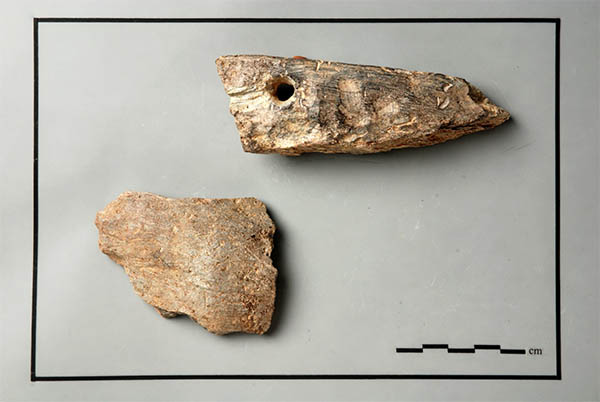Throughout the summers of 2009, 2011, and 2012, the Community Archeology Program (CAP) and professional archaeologists from the Public Archaeology Facility (PAF) completed a series of excavations at the prehistoric John Moore Farm site in the City of Binghamton, Broome County, New York. The John Moore Farm site is situated on an alluvial terrace adjacent to the Susquehanna River, just west of the confluence with the Chenango River. PAF archaeologists and CAP participants recovered an abundance of prehistoric artifacts and identified multiple cooking hearths and pits. Diagnostic projectile points, pieces of stone bowls made from steatite (a soft rock also known as soapstone), and radiocarbon (AMS) dating suggested a series of Late Archaic (roughly 2500 B.C.) and Transitional (1600 to 1000 B.C.) Period camps at the site.
The earliest people who visited the site were associated with the Late Archaic Lamoka/Vestal phase. They left behind relatively low numbers of hunting tools and probably did not stay here long. Carbon from two hearth features submitted for analysis dated this period of site use to roughly 2800-2500 B.C. The following period of land use at the site was much more extensive/intensive. Hunter-gatherers with artifacts associated with the Transitional Period spent more time in this area. The bulk of this Transitional Period camp contained a high number of Susquehanna-Broad projectile points, a diagnostic trait of this time. Other Transitional Period point types identified at the site include the Perkiomen type and a few possible Orient/Dry-Brook types. Three radiocarbon dates on material from hearth features showed that people camped here from approximately 1500-200 B.C. Other typical Transitional Period artifact types included the 53 pieces of steatite bowl fragments, as well as tools made of non-local raw materials, such as jasper and rhyolite.
Analysis of six steatite bowl fragments traced these bowls to source quarries in southeastern Pennsylvania, northern Maryland, and northern Virginia. This suggests that the people who camped here had connections to hubs of trade and interaction with other groups within the Chesapeake Bay region.
